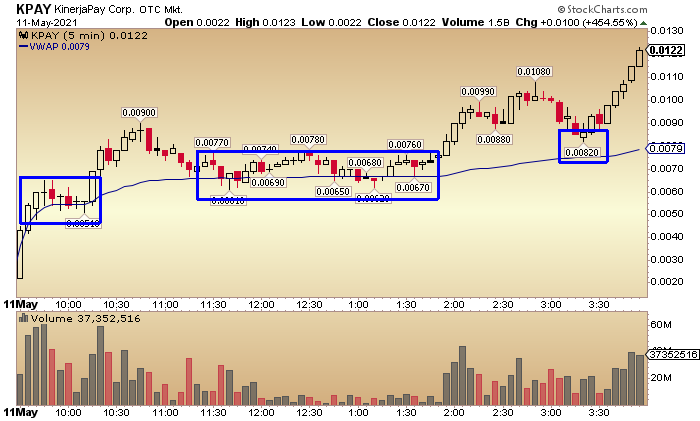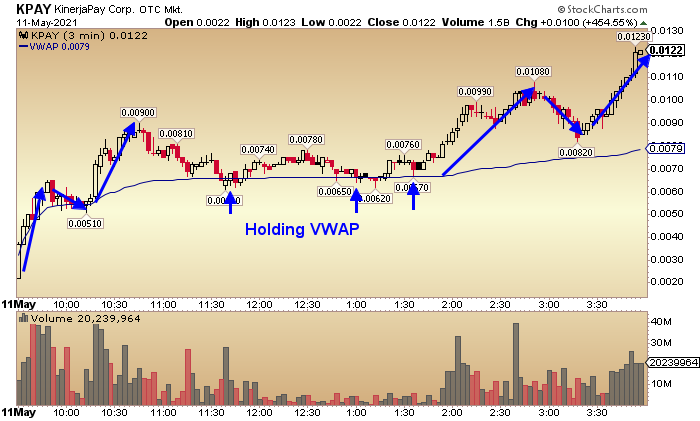Traders are constantly searching for ways to improve timing on their entries and exits. And if you’re one of them—today’s lesson is critical.
I’m going to shed some light on a little secret of the pros by showing you how I use the volume weighted average price (VWAP) line in my trading.
It sounds intimidating, but don’t worry…I’ll break it down so you can see how simple, yet valuable, it really is.
The Basics of VWAP
Due to a basic lack of knowledge, many traders shy away from even learning about it.
That’s a shame because there’s nothing scary about VWAP.
For one… The software does all the calculations for you. Just click on your charting indicators list and add it.
Secondly, it’s an indicator that professional traders use to gauge the market and judge performance, so I find it to be a useful tool to have in my trading arsenal.
So what is VWAP anyway?
Well, it stands for volume weighted average price (VWAP), and it simply tells you the average price a security has traded at throughout the day, taking into account the trading volume related to each price.
The “trading volume” aspect is what sets VWAP apart from just a simple moving average. Prices that have seen larger influxes of volume will be given more weight than areas where trading volume is light.
One useful thing about VWAP is that it can often tell me how bullish or bearish traders feel towards a stock – if the shares are trading above their VWAP, it shows me buyers are interested at increasingly high prices. If the shares fall below the VWAP, it correspondingly shows there’s falling demand for the shares, too.
And most importantly, VWAP can act as potential support or resistance and in an upward trending stock, a pullback to the VWAP can be used as a buying opportunity.
Here’s what it looks like on the 5-minute chart for KPAY.

I highlighted a few different areas where the stock hit the VWAP line so you can see how it acted as support that day.
So when I’m thinking about buying into a trade, I like to see the stock hold above this critical level. Obviously I don’t want to buy into a bearish stock that’s heading in the wrong direction.
Because of this, I can look to the VWAP to help me time my trades and determine whether or not a stock is likely to continue its recent strength, or whether a pullback could be the start of a trend reversal.
Using VWAP to Day Trade
VWAP provides little information by itself and certainly isn’t something to trade without context. I focus on two primary ways to implement VWAP in my trading.
First, I use it as a simple gauge of bullishness or bearishness. If a stock continues to trade above its VWAP consistently throughout the day, that tells me there are a lot of buyers pushing the stock in their direction.
The second way I use the VWAP is a price level to trade against. Usually, I like to use it as support after a significant jump in a stock.
You can see an example here in the 3 minute chart of KPAY below:

KPAY makes a higher high and higher low in the morning, which happens to be one of my favorite patterns to trade (more on this in future posts). I know it’s early in the day though, so instead of jumping in, I look for a pullback toward VWAP at the $.0065 area as support.
If price holds the VWAP, it indicates to me that the buyers are still in control. In that case I will keep it on my watchlist for a potential afternoon trade, looking for the potential of a continued move up off of VWAP.
So while the volume weighted average price (VWAP) line may sound like an advanced tool that a newbie trader won’t understand, it’s nothing of the sort.
Put it on your chart and pay attention to the way price reacts to it. Being that it’s used by professional traders everywhere, it’s nothing to shy away from. And once you learn to use it, you’ll see how simple and helpful it really is.
But don’t start using it as a stand alone trading signal. There is no such thing. That’s why I use multiple indicators, price action, and years of experience and knowledge all combined to find and choose my trades.
And something to keep in mind as you start exploring…
VWAP is a single-day indicator, and is restarted at the open of each new trading day. It is used as an intraday indicator for trading and for institutional traders to “get the right price.”
As mentioned before, I personally use it to gauge the bullishness/ bearishness of a stock and as a potential support/ resistance level.
The best way to learn is to add it to your chart and watch… notice how price reacts to it in different environments; news, company earnings, if the market is up/ down etc…
Good luck, I hope you learned something new. And don’t forget to add me to your safe list to keep me out of your spam so you can tune in next time without digging through your junk folder.






13 Comments
Thanks . Useful tips I didn’t fully understand before.Keep it up always with the Good Works .
Many thanks will give it a go.
Hi Jeff.
Thank you very much for shedding light on VWAP.
I have heard about it but had never used it before.
Will definitely give it a try.
I liked this program and I want to add it to my way of trading
You explained that very clear. Thanks
Thanks for sharing that information to us day traders with little knowledge of it
Thanks Jeff for your help!
Great info, thanks! You always are a fantastic educator.
Beautifully written, simple to understand and very useful in trading in general. Keep up the great work Jeff. These articles should be saved and reviewed in the future. Thanks a million!
Sam C. T.
good morning thxs for all these tips ,puts you more in tune with the candles and more great!i love it all
Thank you for this valuable and sensible information. I will be grateful for any additional educational assistance you would be kind enough to provide.
Hi Jeff
Could you guide me please to enrol on a PennyPro course as I am looking on line to no avail.
Thanks.
Val
never new what it was used for, ,great information